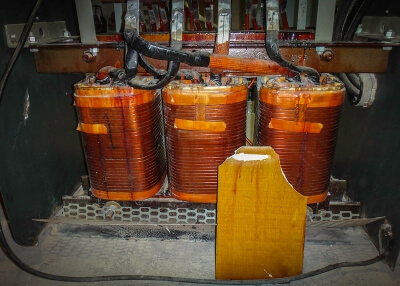Power Plant Workers and Asbestos
Power plants workers suffer higher rates of mesothelioma and asbestosis because of the exposure they encountered using asbestos products on the job. Handling asbestos insulation, asbestos pipes and asbestos in boilers caused many workers at power plants to become ill.

Written by Michelle Whitmer | Scientifically Reviewed By Arti Shukla, Ph.D. | Edited By Walter Pacheco | Last Update: March 25, 2024
How Are Power Plant Workers Exposed to Asbestos?

Power plant workers most at risk for asbestos exposure were hands-on, blue-collar employees whose job descriptions included installing and maintaining pipes and electrical appliances. Records show that asbestos-containing insulation was problematic for their health later in life. Upgrading the plant’s machinery often required workers to cut or saw through existing asbestos products before installing additional asbestos materials.
Many plant workers sprayed asbestos insulating material directly onto heated machinery such as boilers. Others applied asbestos insulation to pipes, seals, pumps and gaskets. One former plant worker specifically recalled creating asbestos dust while drilling and bolting General Electric breakers onto a turbine.
Supervisors, administrators, engineers and office workers who did not handle asbestos products directly may have been exposed to asbestos at work. Poor ventilation in many plants allowed airborne asbestos to circulate throughout the facility for extended periods of time.
Today’s exposure hazards are more controlled than they were in previous years, but they do still exist. In October 2011, at least 12 workers were exposed to asbestos while cutting pipes at the Surry Nuclear Power Plant in southeastern Virginia. The plant lacked the equipment to measure the extent of the exposure, but workers did note that at least three trailers were covered in the dust. The pipe manufacturer paid a $4,900 fine for failing to label its product.
Asbestos Products Associated with Power Plant Workers

Workers in power plants were exposed to a number of asbestos-containing products, including:
- Acoustic Plaster
Acoustic plaster provided noise reduction inside power plants, and adding asbestos provided additional fireproofing properties.
- Asbestos Blankets
Asbestos-containing blankets were used to prevent burns, control heat and prevent fires in power plants.
- Asbestos Pipe Covering
The pipes in power plants were commonly wrapped with asbestos insulation to control the heat radiating from them.
- Asbestos Boilers
Industrial boilers contained asbestos insulation, gaskets and packing.

- Asbestos Panels
Paneling containing asbestos was used throughout power plants as an effective form of insulation and fireproofing.
- Compounds
Repairing compounds used in power plants often contained asbestos to provide strength and heat resistance. For example, asbestos joint compound was used to make repairs on pipes.
- Gaskets
Asbestos gaskets were widely used on all types of equipment in power plants.
- Mastic
Sometimes called caulk, asbestos-containing mastic was used to create seals and make repairs.

- Cement
Asbestos-containing cement was used for many purposes in power plants. For example, asbestos cement pipes were used for their heat resistance, cement blocks were used to make fireproof walls and covers for electrical equipment, and cement compounds were used to make repairs.
- Firebrick
Asbestos was used to make firebricks because the fibers can withstand extremely high temperatures without breaking down. Firebricks were used in power plants as a fireproof material to construct walls and barriers.

Learn about your diagnosis, top doctors and how to pay for treatment.
Get Your Free GuideCompanies That Manufactured Asbestos Products
The companies that manufactured asbestos products used by power plant workers include big corporations, such as General Electric, and smaller companies such as Kilnoise.
- Allis-Chalmers Manufacturing Co.: Pumps that contained asbestos gaskets and packing were made for power plants by Allis-Chalmers.
- Durabla Manufacturing Company: Durabla made a product used in power plants known as the Durabla Black Gasket. These gaskets contained asbestos.
- General Electric: GE’s power plants used insulation, cables, furnaces and wires that contained asbestos.
- Georgia-Pacific: Several of the company’s products were used in power plants and made by Georgia-Pacific’s affiliate, Bestwall Gypsum Company. Some of these asbestos-containing products included gypsum wallboard, acoustical plaster, joint compounds and drywall adhesives.
- Johns Manville: JM made many asbestos products that were used in power plants, including insulating cement, block insulation, panels, sheets and caulking.
- Kilnoise: This company made asbestos-containing acoustical plaster used in power plants.
Power Plant Workers and Mesothelioma
Several studies have documented increased rates of mesothelioma and asbestosis among power plant workers in the U.S. and internationally. According to a 2022 report by the European Commission, over 70,000 workers died in 2019 from past exposure to asbestos.
- A study completed in 2019 found statistically significant excess cases of mesothelioma and asbestosis among 142,583 nuclear power plant workers in the U.S. The researchers concluded with a control group that asbestos exposure in nuclear power plants caused the cases of mesothelioma and asbestosis, not low-level radiation exposure.
- A 2019 study of mortality among 24,086 construction and craft workers employed at U.S. Department of Energy nuclear sites reported excess deaths from mesothelioma and asbestosis.
- One 2019 U.K. study analyzed cancer incidence among 81,616 power generation workers and reported excess cases of mesothelioma among male workers involved in power generation and transmission.
- In 2015, a study published in The British Medical Journal reported asbestos-related deaths in Belgian workers. According to data from 2001-2009, power plant workers are over eight times more likely to die of mesothelioma than the general population.
- A 2010 German study found that power generating employees incurred an average of 20 years of cumulative asbestos exposure throughout their career. Workers who handled power generation tasks had longer exposures than workers in charge of power distribution or gas supply. The same study found that out of 8,632 power plant workers, 3,479 employees handled products that contained both chrysotile and crocidolite asbestos during their careers. Another 1,545 workers handled only chrysotile products, while an additional 613 employees worked exclusively with crocidolite.
- A smaller study from 1979 found that asbestos exposure in power plants significantly corresponded with pleural thickening, pleural calcification and chest pain in former employees. Roughly 33% of workers had ferruginous bodies (markers of asbestos exposure) in their sputum; these workers were more likely to also have gastrointestinal symptoms and hoarsening of the voice.
Mesothelioma is a rare cancer that is nearly exclusively caused by exposure to asbestos. There is no cure for the cancer, but treatments are available to help people live longer with the disease. If you’ve been diagnosed with this condition, find a mesothelioma specialist to handle your health care.
Asbestos exposure causes other types of cancer, including lung cancer, ovarian cancer and laryngeal cancer. It also causes a pulmonary disease, known as asbestosis, marked by progressive scarring of lung tissue.
Some power plant workers unknowingly brought asbestos fibers into their homes on their work clothes, which led to secondary exposure among their loved ones. Secondary asbestos exposure is a known cause of mesothelioma, and families affected by this form of exposure have legal options to seek compensation.

We have more than 50 years of combined experience helping mesothelioma patients.
Chat NowCompensation for Exposed Power Plant Workers
Power plant workers who develop asbestos-related diseases may be eligible to file claims for asbestos exposure, including personal injury lawsuits or asbestos trust fund claims seeking compensation for medical costs and other expenses. Those who lost a loved one may qualify to file a wrongful death claim.
- In 2018, a Florida jury awarded more than $21 million to Regina and Richard Batchelor, who claimed Richard Batchelor developed mesothelioma from asbestos exposure he was subjected to while working at Florida power plants. Those facilities included the Turkey Point power plant, Cutler Power Plant and Riviera Beach electric plant. Defendant Bechtel Corp., which performed overhaul work at the Turkey Point plant, appealed the verdict and the appeals court granted a rehearing. The Batchelors petitioned for a discretionary review and Bechtel filed a briefing with the Florida Supreme Court arguing for a reversal of the verdict. The outcome of the case remains unpublished.
- A Massachusetts jury awarded $7.55 million to power plant worker Gerald Sylvestre in 2017. He claimed he developed mesothelioma through exposure to asbestos insulation provided by New England Insulation Co. at a New Hampshire power plant where he worked.
- In 2017, a South Carolina jury awarded $300,000 to Dale and Brenda Jolly. They claimed Dale Jolly’s mesothelioma was caused by exposure to asbestos joint compounds and wall textures he used while working as a pipe fitter and inspector at Duke Energy power plants from 1979 to 2003.
If you’re a power plant worker diagnosed with mesothelioma, it is in your best interest to work with an attorney specializing in asbestos litigation. Try to find a mesothelioma attorney who has experience securing compensation for other power plant workers, because this area of asbestos litigation is complex and should be handled by an expert.
This Page Contains 15 Cited Articles
The sources on all content featured in The Mesothelioma Center at Asbestos.com include medical and scientific studies, peer-reviewed studies and other research documents from reputable organizations.
- European Commission. (2022, September 28). Questions and Answers: Towards an asbestos-free future. Retrieved from https://ec.europa.eu/commission/presscorner/detail/en/qanda_22_5678
- U.S. Bureau of Labor Statistics. (2021, April 9). Power Plant Operators, Distributors, and Dispatchers. Retrieved from http://www.bls.gov/ooh/production/power-plant-operators-distributors-and-dispatchers.htm
- Ringen, K. et al. (2019, September). Mortality of older construction and craft workers employed at department of energy nuclear sites: Follow-up through 2016. Retrieved from https://pubmed.ncbi.nlm.nih.gov/31380577/
- Sorahan, T.M. (2019, August). Cancer incidence in UK electricity generation and transmission workers, 1973-2015. Retrieved from https://pubmed.ncbi.nlm.nih.gov/31375830/
- Mumma, M.T. et al. (2019, July). Mesothelioma mortality within two radiation monitored occupational cohorts. Retrieved from https://pubmed.ncbi.nlm.nih.gov/31290725/
- Lexis Legal News. (2018, September 10). Contractor: Lack Of Worksite Control Required Reversing $21M Asbestos Award. Retrieved from https://www.lexislegalnews.com/articles/29678/contractor-lack-of-worksite-control-required-reversing-21m-asbestos-award-
- Lexis Legal News. (2017, September 22). Massachusetts Jury Awards $7.55M In Asbestos-Insulation Case. Retrieved from https://www.lexislegalnews.com/articles/20649/massachusetts-jury-awards-7-55m-in-asbestos-insulation-case
- Lexis Legal News. (2017, August 4). South Carolina Jury Awards $300,000 To Worker, Wife In Power Plant Asbestos Trial. Retrieved from https://www.lexislegalnews.com/articles/19445/south-carolina-jury-awards-300-000-to-worker-wife-in-power-plant-asbestos-trial
- Van den Borre, L. & Deboosere, P. (2015, June 24). Enduring health effects of asbestos use in Belgian industries: a record-linked cohort study of cause-specific mortality (2001-2009). Retrieved from https://bmjopen.bmj.com/content/5/6/e007384
- Justia. (2012, September 5). Crane vs. A.O. Smith Water Products Co. Retrieved from http://statecasefiles.justia.com/documents/new-york/other-courts/2012-ny-slip-op-32315-u.pdf?ts=1347463218
- The Virginian-Pilot. (2011, October 24). Workers exposed to asbestos at Surry power plant. Retrieved from https://www.pilotonline.com/news/article_d8eca5dd-9a82-5bb1-a998-1d72dfc05251.html
- Justia. (2011). Montgomery vs. A.W. Chesterton Company, et al. Retrieved from https://cases.justia.com/delaware/superior-court/09c-11-217-asb-0.pdf?ts=1323890163
- Felten, M.K. et al. (2010, June 25). Retrospective exposure assessment to airborne asbestos among power industry workers. Retrieved from http://www.occup-med.com/content/5/1/15
- Hirsch, A. et al. (1979). Asbestos risk among full-time workers in an electricity-generating power station. Retrieved from http://www.ncbi.nlm.nih.gov/pubmed/294164
- NEI. (n.d.). Advanced Nuclear Energy. Retrieved from https://www.nei.org/advanced-nuclear-energy







